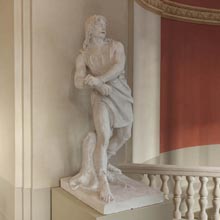
material: plaster
dimensions: 195 × 81 × 103 cm
description: A Roman slave is trying to free himself from his shackles. Dressed in a tunic baring his athletic legs, the man is portrayed standing with his legs wide astride at the moment of swinging his torso. The dynamic representation emphasizes his musculature. This strong, dreadful Slav is an allegorical figure – he is the personification of the partitioned Poland endeavouring to regain independence. The characteristic hairstyle – long plaited hair – reveals the different identity of the ancestor of Poles and the Romans inflicting pain on him. The artist rendered all details of the attire, restlessly folded drapery, a leather belt and thong sandals with meticulous exactitude. The sculpture was made in Vienna when Stanisław Lewandowski was in his last year of the Academy of Fine Arts there. An allusion to Hellenistic ancient art, clear in the way of treating the form, is characteristic of the academic approach of sculptors in the second half of the 19th century. They tried to equal ancient masters in technical brilliance and the clear expression of the message. Agata Małodobry
exposition: The Gallery of 19th Century Polish Art in Sukiennice,
The Cloth Hall, 1, Main Market Square
key: Realism, polish impressionism, beginnings of symbolism >>>
dimensions: 195 × 81 × 103 cm
description: A Roman slave is trying to free himself from his shackles. Dressed in a tunic baring his athletic legs, the man is portrayed standing with his legs wide astride at the moment of swinging his torso. The dynamic representation emphasizes his musculature. This strong, dreadful Slav is an allegorical figure – he is the personification of the partitioned Poland endeavouring to regain independence. The characteristic hairstyle – long plaited hair – reveals the different identity of the ancestor of Poles and the Romans inflicting pain on him. The artist rendered all details of the attire, restlessly folded drapery, a leather belt and thong sandals with meticulous exactitude. The sculpture was made in Vienna when Stanisław Lewandowski was in his last year of the Academy of Fine Arts there. An allusion to Hellenistic ancient art, clear in the way of treating the form, is characteristic of the academic approach of sculptors in the second half of the 19th century. They tried to equal ancient masters in technical brilliance and the clear expression of the message. Agata Małodobry
exposition: The Gallery of 19th Century Polish Art in Sukiennice,
The Cloth Hall, 1, Main Market Square
key: Realism, polish impressionism, beginnings of symbolism >>>












